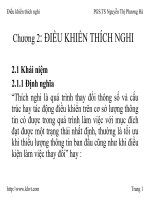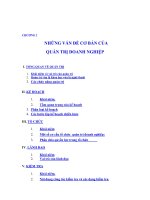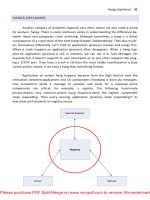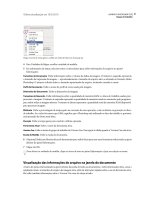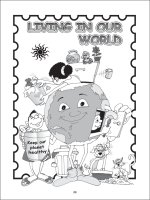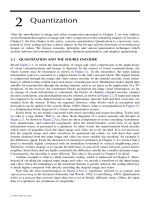Tài liệu Helping Our Planet Earth P2 doc
Bạn đang xem bản rút gọn của tài liệu. Xem và tải ngay bản đầy đủ của tài liệu tại đây (1.46 MB, 20 trang )
29
What to do:
1. On each square card, draw and cut out a pattern of
5 or 6 pieces. This should be prepared before the
class.
Example patterns
2. Form 5 groups (or more depending on the number
of students in your class). Ask students in each
group to choose an observer for the group.
3. Read the instructions to the whole group: “Each
group has an envelope, which has pieces of
cardboard in it. Open the envelope and distribute
the pieces of cardboard to each member of the
group. All group members (except the observer)
must have at least one piece of card. The role of the
observer is to ‘observe’ and take note of what is
going on in the group during the activity.”
4. The task for each group is to put the pieces of card
together to form a square. There are two important
rules each group member must follow:
o No one should speak or signal during the exercise.
o The piece of card belongs to the person holding it.
He/ she decides what to do with it!
5. The task is completed when each group has
completed the square.
6. Repeat the activity, but this time allow group
members to talk to each other.
Purpose:
To understand the importance of
working together.
Time: 45 minutes
Materials: Six envelopes labeled A,
B, C, D, E, and F. In each envelope
is a square cut into 5 pieces- use
hard cardboard to cut the patterns.
Note: This is for a class size of 30
students. If you have over 40
students, increase the number of
squares or cut pieces per square.
Curriculum Connections:
English- oral expression; pre-
writing activity;
Maths- geometry; basic shapes;
making shapes; position &
movement; spatial concepts; using
geo-boards; symmetry;
Social/ Health Science- considering
others; noise; relationships &
attitudes; managing the family
environment; class meeting; social/
civic education;
Basic/ Elementary Science-
upsetting & restoring the natural
habitat;
Skills- promote logical thinking;
cooperation; collaborative learning;
sharing; sorting & linking shapes;
reasoning; appreciation of other
perspectives or ideas.
Note:
To make the activity simpler or
easier to do:
-cut simpler patterns;
-give each group an uncut square
to ‘fit’ their pieces on;
-indicate the top and bottom of
each piece.
Activity- Cooperative Squares
30
Teachers Guide HOPE - HELPING OUR PLANET EARTH
7. Ask the observers from each group to comment on what happened or what they noticed
during the group activity.
Deconstructing the activity:
It is important for the teacher to spend time facilitating the deconstruction as students will have
their own interpretations and lessons they have learnt from the activity. Questions that could be
asked to prompt thought and responses:
o What happened? Was the task achieved quickly? Why or why not?
o What did each group do to be able to put the squares together?
o Did the group members cooperate?
o How does it feel to work without talking?
o Did anyone feel frustrated? How did you deal with this?
o What does this show us about communication?
o Did anyone break the rules? How?
o What were the differences between the first time the activity was done and the second
time?
o Is this similar to what is sometimes experienced in the real world? In our communities,
schools, homes? Discuss the different behaviour types experienced during the activity
and relate this to real- life situations.
Students involved in a fun group activity
31
Teachers Guide HOPE - HELPING OUR PLANET EARTH
What to do:
1. Place the signboards- Agree; Disagree; Don’t Know- in
different corners of the classroom.
2. Ask the students to stand in the middle of the room.
3. Read out a statement and ask them to move to
whichever side they choose. If they agree with the
statement, then they move to the agree side; if they
disagree they move to the disagree side and if they are
not sure, they move to the ‘Don’t Know’ sign.
4. Explain to students that the point of the exercise is not
to see how many people agree but to see why students
are standing where they are. The goal is to exchange
student ideas and stances on topics and for students to
challenge other student’s point of view in a non-
threatening atmosphere.
5. Try and choose or think of statements that include
local, national and global topics. Some statements
might include e.g. More tourism would be good for Fiji
or Everyone in the world should only have one child.
6. Once the students have positioned themselves and
decided where to stand, choose a few students to
explain why they chose to stand where they are. Do
not assume that all students take a stand for the same
reason- ask questions to get a broad range of
responses for students taking a stand on an issue.
Purpose:
To think critically about an issue
and clarify individual values.
Time: 20 minutes
Materials: Three old cardboards or
A4 sheets- to be used as signboards
with either ‘Agree’, ‘Disagree’ and
‘Don’t Know’ written on;
Statements to use for the activity.
Curriculum Connections:
English- oral expression; dialogue;
debate; pre-writing activity;
Social/ Health Science- considering
others; relationships & attitudes;
effects of change; resolving
conflicts; cultures & communities;
resource use;
Basic/ Elementary Science-
upsetting & restoring the natural
habitat; changing ecosystems; water
cycle;
Skills- promote logical thinking &
decision making; critical thinking;
express ideas & accept different
viewpoints; communication &
rationalising;
Example Statements:
* Water pollution doesn’t involve me;
* I put all my rubbish in the bin;
* I tell other students at this school
why they should not throw rubbish
on the ground;
* Logging is bad for the environment!
* Plastic bags should be banned!
* Big families are good!
* We shouldn’t eat turtle eggs!
* Chiefs should put more taboos on
reefs!
* Dogs are better than cats;
* Boys are stronger than girls;
Activity- Where do you stand?
32
Teachers Guide HOPE - HELPING OUR PLANET EARTH
7. After a few explanations, ask if there are any students who would like to change their
stand. Allow them to take new positions if they change their mind.
Deconstructing the activity:
o What lessons were learnt when conducting the activity?
o How does it feel to take a stand?
o What did you do or what did you have to consider before you decided where to stand?
o Was it useful to listen to other points of view? Did they differ greatly from your own?
o Were you able to understand the issue better from the different view points raised?
o Was there a student or a small group of people standing alone? How did they feel?
o Were there students who followed friends to the same signboard? Is this really how they
feel about the issue or is their stand different?
‘Where do you stand?’ is a great way for students to exchange ideas and question each other’s
views on a range of topics. The activity is very simple to conduct, yet can lead to some in- depth
discussion and sharing of differing points of view.
Reflective skill
Deconstructing the activities is very important so that activities gain deeper meaning and students receive
messages that they themselves have discovered.
Here is an example of a quick (ten minute) activity to reflect on how the students felt about the activity.
TEMPERATURE CHECK!
This activity has students talk constructively about their experiences. The purpose of a temperature check
is to give each person an opportunity to say what is on their mind or in their heart after a new experience.
• Tell students you want to take a temperature reading, not of the outside, but of the inside of each
person in the class. If the class is very big, have ten students volunteer themselves to form a circle
sitting in the class with the other class members in a large circle around them.
• Let students know that they can talk about how much they enjoyed what another student said, talk
about what still puzzles them and bring up unanswered questions from the activity, make
recommendations for the future, or hopes and aspirations gained from the activity or for action from
what they have talked about.
• In our experience students feel uncomfortable about the temperature check when it is first introduced.
Yet it is a great way to cultivate open-minded confident students. After using the activity a few times we
have found the students get the feel of the activity and begin to enjoy it and lead to good discussions.
33
Teachers Guide HOPE - HELPING OUR PLANET EARTH
What to do:
1. Construct a diamond of squares on newsprint (as
below) for the students to place their cards.
Agree most
Disagree most
2. Use old cardboard to write the statements. Example
statements are given.
3. Divide the students into groups and give out the
newsprint and ranking cards. Explain that they have
nine cards that need to be arranged (ranked) on the
newsprint.
4. Ask them to read all the statements on the nine
cards, discuss and put the one that they agree most
with in the top box and the one they disagree most
with at the bottom.
5. Once they agree on the placement of cards as a
group, they will then present this to the whole class
with their reasons for the way they have ranked the
issue.
Deconstructing the activity:
o How did the group decide where to place the cards?
Was this done easily? Was everyone involved
equally?
o Which was the hardest and easiest decision to
make?
o What skills did students have to use to arrive at a
decision? Do they use these skills at home, at
school, in the community? How?
Purpose:
To develop cooperative decision-
making and communication skills.
Time: 40 minutes
Materials: Ranking cards, cello tape,
newsprint
Curriculum Connections:
English- dialogue; pre-writing
activity; poetry writing;
Social/ Health Science- relationships
& attitudes; effects of change;
cultures & communities; managing
family/ community resources;
Basic/ Elementary Science-
upsetting & restoring the natural
habitat; man and changing
ecosystems;
Skills- promote logical thinking &
decision making; critical thinking;
express ideas & accept different
viewpoints; communication &
rationalising; prioritising.
Note:
The nine statements can cover any
issue;
Example Ranking Cards:
This example focuses on gender in
schools. The discussion itself is the
most important part of the activity.
* Boys and girls should line up
separately.
* Girls are smarter than boys.
* Male teachers always teach older
children in schools.
* Girls enjoy writing stories more
than boys.
* Boys are better at Maths.
* Girls talk just as often as boys but
don’t get told off as much.
* The school soccer team should
include boys and girls.
* Boys and girls should be treated
equally
* Boys spend more time doing
homework than girls.
Activity- Ranking
34
Teachers Guide HOPE - HELPING OUR PLANET EARTH
What to do:
1. Write a list of planet items for sale on newsprint or on
the board. Encourage students to add some items to
the list. Ask: ‘What are items of the earth- our planet
that we can sell?’
2. Place students into groups of four or five students
per group. Explain the activity to the class. In this
activity, you will be selling items of the Planet Earth.
The items will be auctioned. Ask students if they know
what an auction is. You may want to spend a few
minutes explaining the function of auctions and what
happens at an auction. Students will pretend that they
are bidders and can buy the items if they wish and
can afford to. The bidding teams will need to decide
what items to buy and how much they would like to
spend.
3. Each team has $1000 to spend. This is the amount of
money that they have to bid with. Ask teams to select
one student to act as the ‘bank’. The bank keeps a
record of how much has been spent and lets members
of the group know how much is left.
4. The teams can decide to combine with or borrow from
another bidding group to purchase planet items.
Purpose:
To express attitudes and values
towards the environment.
Time: 30 minutes
Materials: newsprint, coloured card
for bids
Curriculum Connections:
English- vocabulary; jargon; oral
expression; role play;
Maths- money; shopping; problem
solving; profit and loss; cost price;
sales;
Social/ Health Science- relationships
& attitudes; important places in the
environment; resources; shopping
skills; family and social living;
Basic/ Elementary Science- upsetting
& restoring the natural habitat; man
and changing ecosystems; why
organisms live in certain places;
Skills- promote values; competitive
skills; bargaining; decision making;
critical thinking; logical &
conscientious thinking;
communication & rationalising;
prioritising.
Note:
In this activity the teacher (facilitator)
takes on the role of an auctioneer.
And the Planet is for sale!
Teachers in Savusavu found this
activity very lively and fun. We were
able to deconstruct it in many ways,
looking at how and why different
people place higher and lower values
on parts of nature. The activity
encourages participants to publicly
express their attitudes and values
towards the environment in an
enjoyable way.
Activity- Planet for Sale!
35
Teachers Guide HOPE - HELPING OUR PLANET EARTH
5. You may wish to give each bidding team a coloured card to raise if they would like to bid, or
each team should choose a team member to raise his/ her hand if the team would like to
bid.
6. Give the teams a few minutes to discuss before beginning the auction. Remind students
that the items for sale are listed on the board.
7. Set the scene by welcoming ‘bidders’ to ‘The Sale of the Century!!’ and go through the
items for sale. Bidders are encouraged to bid for those items they would most like.
8. The auctioneer needs to remain lively, you may say (for example), “Okay ladies and
gentleman, today I welcome you to ‘THE SALE OF THE PLANET’, yes! That’s right! This is
a once in a lifetime opportunity to buy a piece of the planet! After this nothing will be left to
purchase! Roll up! Can I have a starting bid for all the forests in the world? Yes Sir, What’s
your bid? Ok, we are starting at 400 for all the forests, can anyone raise that bid? Yes, they
can, we have 600 in the back corner, going once, going twice, going three times (pause and
see if there are anymore bids) – sold to the man at the back! Congratulations sir!’
9. The auction finishes when a number of bidders run out of money.
Deconstructing the activity
o Discussion can begin by reflecting on what price people were willing to pay for different
items.
o You may ask why such a high price was put on one item and not on another.
o Rank the items in order of highest to lowest according to the price they sold for.
o Was there intense competition for some items and not for others? Why?
o Did the auction atmosphere push up the price for some items? Can they give examples?
o Do they think a price can or should be put on an environmental resource (item)? Why or
why not?
o Do we take nature too much for granted unless we think about putting a price on it?
o As a variation for older students you may like to randomly distribute cards with differing
amounts of money on them. This will change the atmosphere of the game and promote
follow-up discussion about the relationship of wealth to power and control over the
planet.
This lily pond is in the shape of the
World map
36
Teachers Guide HOPE - HELPING OUR PLANET EARTH

